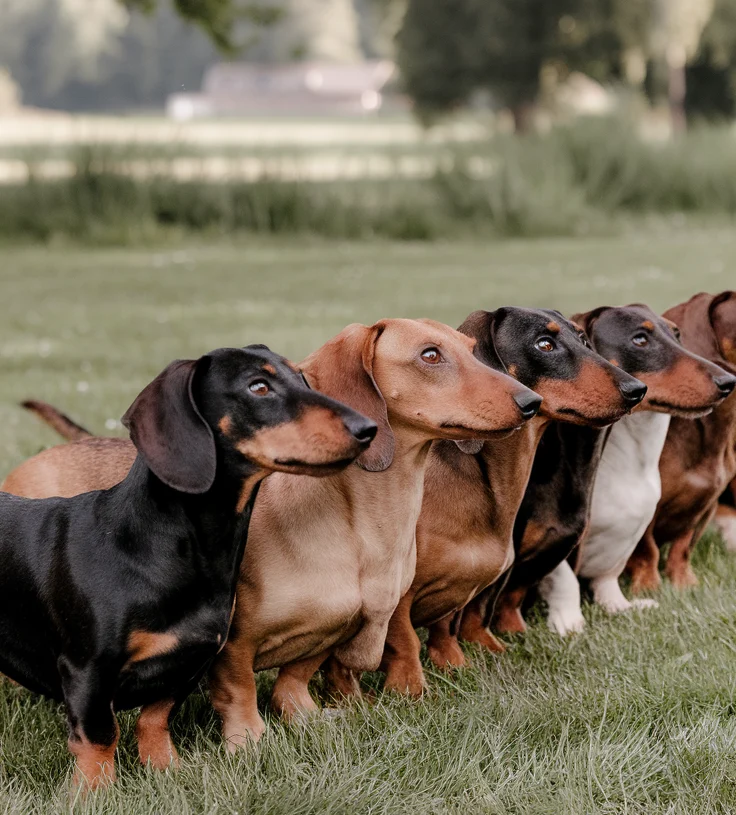The Dachshund Diaries: A Guide to Keeping Dachshunds as Pets

Dachshunds, with their distinctive long bodies and short legs, are among the most recognizable dog breeds. Known for their playful personalities and loyal nature, these small dogs pack a lot of character into a compact frame. Whether you’re drawn to their unique appearance or their spirited attitude, Dachshunds make wonderful companions. Here’s everything you need to know about keeping Dachshunds as pets and ensuring they live a happy, healthy life in your care.
Why Dachshunds Make Great Pets
- Loyal and Affectionate
- Dachshunds form strong bonds with their owners. They are known for their loyalty and love to be close to their family members, often following them around the house.
- Playful and Curious
- Despite their small size, Dachshunds are full of energy and curiosity. They love to play, explore, and engage in activities that challenge their sharp minds.
- Adaptable Companions
- Dachshunds are versatile and can adapt to various living environments, whether it’s an apartment in the city or a house in the suburbs. They are also good travel companions due to their small size.
- Great Watchdogs
- Dachshunds are alert and have a keen sense of hearing. They are often quick to bark at unfamiliar noises, making them excellent watchdogs, though this can sometimes lead to excessive barking.
Choosing the Right Dachshund
Dachshunds come in three coat types—smooth, longhaired, and wirehaired—and each type has its own unique characteristics.
1. Smooth Dachshund
- Short and Sleek: The smooth-coated Dachshund has a short, glossy coat that is easy to maintain. They are the most common type and have a sleek, streamlined appearance.
- Best For: Those looking for a low-maintenance coat with minimal grooming needs.
2. Longhaired Dachshund
- Soft and Flowing: Longhaired Dachshunds have a silky coat that requires regular grooming to prevent tangles and mats. They have a more elegant appearance and are often a bit calmer than their smooth-coated counterparts.
- Best For: Owners who enjoy grooming and want a dog with a luxurious coat.
3. Wirehaired Dachshund
- Rough and Ready: Wirehaired Dachshunds have a coarse, wiry coat that gives them a rugged look. They require regular trimming and have a spunky, energetic personality.
- Best For: Those who like a dog with a distinctive, textured coat and a spirited attitude.
Setting Up a Dachshund-Friendly Environment
- Comfortable Living Space
- Dachshunds may be small, but they appreciate a cozy space of their own. Provide a soft bed in a quiet corner where they can retreat and rest.
- Safety Considerations
- Due to their long backs, Dachshunds are prone to spinal issues, such as intervertebral disc disease (IVDD). Avoid allowing them to jump off high furniture, and consider using ramps or steps to help them navigate elevated surfaces safely.
- Exercise and Playtime
- Dachshunds need regular exercise to stay healthy, but be mindful of their back when engaging in physical activities. Daily walks and gentle play sessions are ideal for keeping them fit without putting too much strain on their spine.
- Toys and Enrichment
- Dachshunds are intelligent dogs with a strong prey drive, so they enjoy toys that challenge their minds and mimic hunting behavior. Puzzle toys, chew toys, and squeaky toys are great for keeping them entertained.
Daily Care and Maintenance
- Grooming Needs
- The grooming requirements of a Dachshund vary depending on their coat type. Smooth-coated Dachshunds need minimal grooming, while longhaired and wirehaired Dachshunds require regular brushing and occasional trimming. All Dachshunds benefit from routine ear cleaning and nail trimming.
- Feeding and Nutrition
- Dachshunds are prone to obesity, which can exacerbate back problems. It’s important to feed them a balanced diet and monitor their weight closely. Divide their daily food intake into two meals to help with digestion.
- Training and Socialization
- Dachshunds can be stubborn, so early training and socialization are key to raising a well-behaved dog. Positive reinforcement methods work best with this breed. Expose them to various people, pets, and environments to help them become confident and well-adjusted.
- Health Monitoring
- Regular vet check-ups are essential to monitor for common Dachshund health issues, such as dental problems, IVDD, and obesity. Keep an eye on their back health and consult your vet if you notice any signs of discomfort or mobility issues.
Fun Facts About Dachshunds
- Hunting Heritage: Dachshunds were originally bred in Germany to hunt badgers, which is why their name translates to “badger dog” in German. Their long, narrow bodies are perfect for burrowing into tunnels.
- Dachshund Races: Dachshund races, often called “Wiener Dog Races,” are popular events in many places. These races highlight the breed’s playful and competitive spirit.
- Famous Dachshunds: Dachshunds have been beloved by many famous figures, including artists like Pablo Picasso and entertainers like Andy Warhol.
Conclusion
Dachshunds are more than just a cute, small breed; they are loyal, spirited companions with a big personality in a small package. Their playful nature, combined with their adaptability and loyalty, makes them a delightful addition to any home. By providing them with proper care, attention, and a safe environment, you can ensure that your Dachshund enjoys a happy and healthy life as your devoted companion. Embrace the joy and charm of owning a Dachshund, and experience the unique bond that comes with sharing your life with this remarkable breed.



